Booked Up, with Eric J. Herboth: 'In Search of the Multiverse'
by Eric J. Herboth
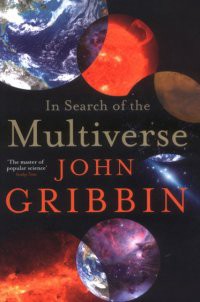
In May of 2008, Brazil’s National Indian Foundation, a government agency, published aerial photos of what was reported to be a tribe of uncontacted peoples living in a remote corner of the Amazonian rainforest. The images depicted several men, painted a bright red and brandishing bows and arrows, ready to attack the mysterious aircraft above. The images were sensational and stirred much controversy, and in an anthropological way pointed out the subtle notion of perspective that lies at the heart of some of the most advanced thinking in theoretical physics. Namely, denied the proper position of reference, can one be cognizant of true isolation? When one can’t see the forest for the trees, how can one consider the landscape beyond the woods? For anthropologists, the relation of uncontacted cultures to our own is the big question. For scientists, it is our relation to everything there is, and could be, that brings a feverish curiosity.

If we were to plot out the milestones of scientific thought and discovery over the course of human history, what would develop would be a graph end-loaded with points in relatively recent times. Mesopotamian clay tablets inscribed some 3000 years ago listed dozens of constellations, but it wasn’t until a few hundred years ago that Nicolaus Copernicus proffered a mathematical model of a planetary system rotating about the sun. Almost all of the information truly relevant to our understanding of the universe has come in the past 100 years with the specialization of various fields (not only astronomy but the refinement of more complex studies such as celestial and quantum mechanics, and the rapid acceleration of theoretical physics). In the space of a few generations the common-knowledge application of “the universe” has gone from making paper-mâché solar system mobiles in the schoolhouse to following the Voyager 1 satellite as it leaves our solar system. In terms of our understanding of the physical realm in which we live, those basic principles of a spherical Earth and a heliocentric planetary system are such outliers on the graph as to be rendered comically quaint; after all, one need not recognize the premise that water is wet to study the ocean. As our ability to draw back and look at the big picture continues to increase it is becoming more and more apparent that the common understanding of the universe is just as quaint.
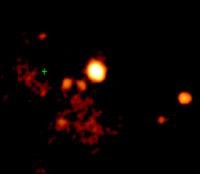
The crazy thing about science is that the more we learn the clearer it is how little we actually know. Through the advent of technology and scientific specialization, rather than being cleared up, our understanding of physical space has become cloudier. Literally. In the 15th century, Isaac Newton made spectroscopic analysis of sunlight split with a prism; a hundred years ago astronomical spectroscopy led to the first actual detection of gas clouds in space. Today, spectroscopy is used to uncover the hidden gravity wells known as black holes, and in turn black holes are thought to possibly create the “seeds” of entire new universes.
As a twist, to explain why gravity is so weak (given our size relative to the Earth, it is far easier than it should be to dunk a basketball or shoot a rocket into space) some theorists consider it to be a force leaking into our universe from somewhere else, where it is much stronger. In short order, our concept of our interstellar surroundings has gone from chaos to cosmos and back again. Those shifting positions of understanding (or lack thereof) are where astrophysicist and popular science writer John Gribbin launched his latest book, In Search of the Multiverse, a sort of Cliff’s Notes-cum-layman’s guide to approaching the latest developments in theoretical physics and their implications for our understanding of not just physical space but reality itself. Though he throws in an (admittedly, technically as theoretically possible as anything else) alarming twist at the end, for the most part Gribbin’s survey on Multiverse thinking is informative, easy reading, and real candy for science theory buffs.
In scientific circles, as physical observation and discoveries have failed to keep pace with the computer-aided expansion of high-level mathematics, the highest levels of exploration have increasingly been shifting from the laboratory to the microprocessor. For decades the advent of technology had yielded discoveries that were documented long before they were understood; as the very stuff around us was revealed as increasingly complex, scientists were often swamped and left chipping away at a backlog of data from observatories and orbiting telescopes, tasked with explaining just what was already “discovered.” Today the momentum of centuries of thought and new data processing capability has pushed the pendulum in the other direction, and more and more scientific experiments are being designed to find what is already predicted. Whereas we once found it and then explained it, now we explain what is yet to be found.
For the staunch empiricist who can’t help being a dreamer at the same time, In Search of the Multiverse excels by giving the rush of a peek into Pandora’s box, considering the mystical around the mathematics without letting the theoretical nature of it all be too much of a bummer. But that shouldn’t scare anyone off; I neither enjoy nor excel at mathematics, and thankfully In Search of the Multiverse is more a philosophical text than a math worksheet. Which is refreshing. The modern age of exploration and science has rendered much of metaphysical philosophy more quaint old-timey hobby than legitimate academic field, but as the extrapolation of mathematical modeling has outstripped the means available to test and observe, the pursuit of understanding has moved back from the quantifiable toward the theoretical. Today the most brilliant minds occupying the absolute razor’s edge of science must balance philosophy and physics, and on that edge rests the theory of the Multiverse.
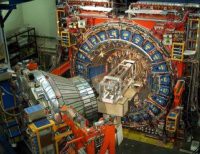
The brilliance of this shift is that if you can think it, it might just be true. This is how we necessarily ended up building the Large Hadron Collider, the huge particle accelerator designed to “find” the Higgs Boson, an elusive particle that was theorized in 1964 but is yet to be observed. Yesteryear’s science fiction is increasingly being tested (if not realized) in today’s experimental physics-several years back, when Steven Soderbergh remade the film adaptation of Stanislaw Lem’s 1961 novel Solaris, he inserted a snippet of new dialogue referencing the Higgs Boson; today scientists are working hundreds of feet underground to try and catch one.
Of course the downside to this shift is that the more we discover, the less we feel we truly know about the complexity of our universe, and what exactly Our Universe even refers to. When there are so many questions (and often times contradictions) within the very tenets of scientific research itself, where does one begin? In Multiverse Gribbin does an admirable job of methodically breaking down the science behind the prevailing ‘facts’ of existence. Or, again, lack thereof. Right off the bat Gribbin plays the ace in the fundamental deck: light. From the time of Isaac Newton’s prism to today’s at-home hair removal lasers, there has been no clean definition of what light really is. The speed of it is an expression in Albert Einstein’s famous equation E=mc², yet the nature of “wave-particle duality” (that light is both and neither a particle and/nor a wave) has led to more questions than Einstein answered, which is how we arrived at quantum mechanics. A duality in such a fundamental phenomenon is in essence the foundation for speculative physics, where irresolution is amplified and turned on its head and uncertainty becomes possibility. Science feeds on answers, and where there isn’t one lies the opportunity to find one. Hence, the spiraling myriad of the 20th Century’s new ideas, one of the most exciting of which was Hugh Everett’s Many Worlds Interpretation of quantum mechanics, which aims to resolve the various paradoxes and dualities that scientists have dead-ended at. As Gribbin goes to great lengths to show, there is no reason why not, and in fact more reason why, our Universe-”the totality of everything in space and time of which we could ever, in principle, have direct knowledge”-is not just one component of a limitless Multiverse.
Of course when going out on such tenuous cosmic limbs, science inevitably finds itself painted into the same corner as religion, in that there is no means of experimental verification of such claims. Scientists can’t provide tangible proof for the Many Worlds Interpretation any more than theologians can substantiate claims of a One True God. Much in the way that a scale is not able to weigh itself, the physical constraints of location and the very influence of observation itself mean that not only is there currently no way to directly verify many aspects of theoretical physics, there never will be. Though it is thought that black holes created in a laboratory can spawn a new universe, the very nature of a Universe implies self-containment, meaning we could never communicate with or study it. (Theorists hope to eventually find some indirect ways of verifying various theoretical phenomena, but those efforts have failed thus far.)
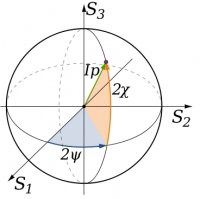
This catch-22 is by no means a facet of Gribbin’s work exclusively, or of Multiverse thinking in general. The scientific method requires that a hypothesis be able to be tested, and that a theorem be proven. This is why ‘string theory’ isn’t known as a ‘string hypothesis’ and why for nearly a century the name Poincaré was followed by the word Conjecture. No matter where you look, science is defined as systematized knowledge based on facts and observation. Verification is at its heart, the means of quality control that eventually led Poincaré to be substantiated and will, short of a parting of the heavens, likely confine Hugh Everett and Max Tegmark and John Gribbin to the realm of pure speculation. Wonderful speculation, but still speculation.
While he does cop to the fact that even the most advanced technology in existence or on the horizon “may not be up to the task of testing such predictions,” Gribbin doesn’t spend a lot of time acknowledging the
deficiencies inherent in an untestable theory. Neither does he take forceful stabs at any new ideas on testing the Many Worlds Interpretation. One can hardly blame him, but the point of science is discovery, not faith.
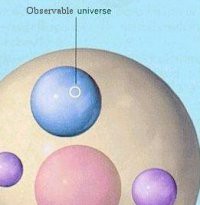
Which is exactly why the notion of a Multiverse is, for many people, more out-there than religion. It is also why physicists like Columbia University’s Peter Woit have been renouncing the shift of intellectual talent away from the quantifiable and toward theoretical practices as a brain drain on the sciences and a glorification of intellectual masturbation. Woit, a critic of Multiverses and M-theory (multidimensionality) and Gribbin himself, loves to quote Wolfgang Pauli, the Austrian quantum physicist nominated by Albert Einstein for the Nobel Prize in Physics, who famously distilled the principle of falsifiability by saying that purely theoretical thinking was “not even wrong.” Although the Many Worlds Interpretation can’t be proven, it also can’t be disproved. Then again, to the physicists who understand and support the science and logic behind the Many Worlds Interpretation (which is certainly not all, but a majority of relevant scientists), those of us stuck at the vantage point of a singular universe seem as silly and naive as those Amazonian tribesmen can seem from under the wing of an airplane. It may be out-there, and stuck in a scientific hamster wheel of unverifiability, but the idea of a Multiverse sure is exhilarating to think about nonetheless.
What Gribbin understands, and does well to spell out, is that such concepts are not just exhilarating but are hard to grasp, not just for readers but for science as well. In every discovery that scientists make, for each period at the end of a definitive statement there seems to be an exponential number of question marks. Taking the long view, those question marks have often times turned out to be more important than the periods; no matter how long and hard scientists search, they are unable to find a “unified field theory” (to explain everything at the particle level) that works within the context of what is known. The reason is both simple and confounding: just as you can’t fit a basketball into a piece of paper, you can’t fit the principles of a Multiverse neatly into a Universe.
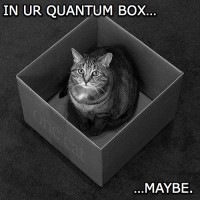
Though sometimes in a necessarily cursory nature, In Search of the Multiverse lays out layer upon layer of questions that either relate directly to, or provide a background perspective of reference for, approaching the idea of a Multiverse. The book addresses the size and dimensions of a universe, celestial bodies, black holes, dark matter, mass, gravity, neutrons, wormholes, infinity and the where/when conundrums of spacetime as they pertain to us and our relation to the Multiverse, and everything in between. It isn’t quite as strenuous as an internship with Stephen Hawking, but the book hits the high points-from the basics of Schrödinger’s Cat to the very real possibility that we exist in a Matrix-like level of “reality” within a “consciousness” infinitely superior to ours-with plenty of sound science and historical reference to fill in the lows without ever feeling like filler.
Sure, all of this seems really out-there, and in every sense of the term it truly is. But thanks to Gribbin, the general premises of the Many Worlds Interpretation and all of the facets of Multiverse thinking are approachable. As a choice quote from MIT physicist Max Tegmark puts it at the book’s very beginning, “if we dismiss theories because they seem weird, we risk missing true breakthroughs.” Tegmark’s quote is exceptionally poignant in the discussion of Multiverses, not only in the larger sense but also in the most specific details of the discipline’s origin. It was half a century ago that the physicist Hugh Everett, Gribbin’s hero, first proposed the Many Worlds Interpretation, only to have not just his concepts but also he himself be summarily dismissed as “undescribably stupid” by the preeminent minds of quantum mechanics. Ignorance and skepticism cost the scientific community a good two decades of research into the possibility of limitless worlds, a premise now met with greater acceptance.
But there’s always a hitch in such fantastic notions, isn’t there? Unfortunately, for all the deftness of explanation Gribbin employs throughout In Search of the Multiverse, he can’t resist throwing a curveball in the final chapter by making the kind of huge metaphysical leap that is so off-putting for laymen and scientists alike. Having rolled out an informative and well-organized survey of bullet points on the science behind Multiverse thinking, Gribbin wings at us a theory on the nature of reality that, depending on one’s level of cynicism, smacks of either The Matrix or a new riff on the Intelligent Design contrivance. Gribbin unequivocally assures us that his Designer Universe idea is not the same thing as Intelligent Design, but the distinction is real hair splittery. The notion that we exist on a sub-level of some higher power’s reality, either as a dreamlike construct of their consciousness or, as Gribbin postulates, in a playhouse of physical construction, goes down bitter and leaves a terrible aftertaste.
The idea is frustrating in itself, but Gribbin writes with so little self-skepticism on this outlandish point that it is mildly alarming. To his credit, he doesn’t go completely televangelist; his writing maintains the simple matter-of-factness that mutes any eye-popping, jaw-dropping reactions of total wonderment. But he still brings it with a manner of confidence that feels weirdly like missionary zeal:
A civilization that has the technology to make baby universes might find the temptation irresistible, while at the higher levels of universe design, if the superior intelligences are anything at all like us there would be an overwhelming temptation to improve upon the design of their own universes.
Great, not only are we in the terrarium of a higher power, but we’re an experiment in vicarious redemption? Don’t worry, Gribbin is an avowed atheist, and In Search of the Multiverse isn’t a repackaging of L. Ron Hubbardian crockery. Still, this ending is a real head-scratching moment.
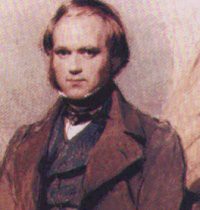
Of the architects of a snow-globe Universe as elaborate as our own, Gribbin conjectures that “the intelligence required to do the job may be superior to ours, but it is a finite intelligence reasonably similar to our own, not an infinite and incomprehensible God.” Considering the fact that we humans not only couldn’t get the Large Hadron Collider up and running until today but that we also have a staggering pool of potential Darwin Award winners each year, such extradimensional beings sure sound unreasonably intelligent, incomprehensible and God-like in comparison.
Einstein’s famous quote, that “the most incomprehensible thing about the Universe is that it is comprehensible,” is a tried and true jumping off point for arguments for and against just about every position on the structure of life that one can imagine. Gribbin, like Christians, asserts that the comprehensibility is no coincidence, but the result of cognizant planning. The distinction between a Creator and a Designer? You say potato…
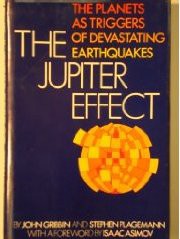
It is lamentable that Gribbin chooses to go out with an ‘in his image’-style theory of super-beings that he feels “provides the best resolution yet” to Einstein’s riddle. Gribbin is no stranger to the Hail Mary Hypothesis (he was somewhat infamous in the late 1970s for co-authoring The Jupiter Effect, which erroneously predicted the destruction of Los Angeles via major earthquakes triggered by planetary alignment), but the bulk of In Search of the Multiverse is such a good read that this foray into X-Files territory is a real disservice.
In Search of the Multiverse is dense with facts and dates and names, but such is the nature of condensing cutting-edge science at the extremes of conceptual understanding into a 200-page book. Though concepts can overlap and blur together, if you can forgive the Intelligent Design-like salvo, the everyday prose with which Gribbin unfolds the science is easily followed, not to mention detailed with plenty of clarifying footnotes and augmented with a glossary of terms and a suggested bibliography for additional reading (which is in turn broken down into texts that Gribbin finds particularly relevant). Gribbin’s style and bullet-pointed presentation ensure that both the scientific novice and the versed academic can be kept at attention. Just take the last couple of pages with a grain of salt-or, in your universe, you can maybe skip them altogether.
Eric J. Herboth is a freelance writer, journalist and artist living in rural central Germany. Over the past ten years he has contributed essays, criticism and analysis to a number of publications, including LAS Magazine, where he is the managing editor. He received degrees in aeronautics and aviation from Saint Louis University as a minor, and is an FAA licensed commercial pilot. He is also a professional bicycle mechanic and retired beekeeper, and once urinated on then-St. Louis Cardinals pitcher Bruce Sutter.
